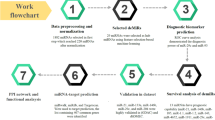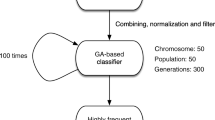Abstract
Purpose
Laryngeal cancer (LC) is the most common head and neck cancer, which often goes undiagnosed due to the inaccessible nature of current diagnosis methods in some parts of the world. Many recent studies have shown that microRNAs (miRNAs) are crucial biomarkers for a variety of cancers.
Methods
In this study, we create a decision tree model for the diagnosis of laryngeal cancer using a created series of miRNA attributes, such as sequence-based characteristics, predicted miRNA target genes, and gene pathways. This series of attributes is extracted from both differentially expressed blood-based miRNAs in laryngeal cancer and random, non-associated with cancer miRNAs.
Results
Several machine-learning (ML) algorithms were tested in the ML model, and the Hoeffding Tree classifier yields the highest accuracy (86.8%) in miRNAs-based recognition of laryngeal cancer. Furthermore, our model is validated with the independent laryngeal cancer datasets and can accurately diagnose laryngeal cancer with 86% accuracy. We also explored the biological relationships of the attributes used in our model to understand their relationship with cancer proliferation or suppression pathways.
Conclusion
Our study demonstrates that the proposed model and an inexpensive miRNA testing strategy have the potential to serve as an additional method for diagnosing laryngeal cancer.





Similar content being viewed by others
Data availability
All code used for this study is available upon request. All other data are publicly accessible.
References
Koroulakis A, Agarwal M (2022) Laryngeal cancer. In: StatPearls [Internet]. Treasure Island (FL): StatPearls Publishing; 2023. https://www.ncbi.nlm.nih.gov/books/NBK526076/. Accessed 23 Jul 2023
Afify AY, Ashry MH, Sadeq MA, Elsaid M (2023) Causes of death after laryngeal cancer diagnosis: a US population-based study. Eur Arch Otorhinolaryngol 280(4):1855–1864
National Cancer Institute (2023) Laryngeal Cancer Treatment (PDQ®)–Patient Version. https://www.cancer.gov/types/head-and-neck/patient/adult/laryngeal-treatment-pdq. Accessed 16 Jul 2023
Jovanović MB (2008) Diagnosis of laryngeal carcinoma. Med Pregl 61(11–12):591–595
Cohen SM, Kim J, Roy N, Asche C, Courey M (2012) Direct health care costs of laryngeal diseases and disorders. Laryngoscope 122(7):1582–1588
Esquela-Kerscher A, Slack FJ (2006) Oncomirs—micrornas with a role in cancer. Nat Rev Cancer 6(4):259–269
Widera C, Gupta SK, Lorenzen JM, Bang C, Bauersachs J, Bethmann K, Kempf T, Wollert KC, Thum T (2011) Diagnostic and prognostic impact of six circulating micrornas in acute coronary syndrome. J Mol Cell Cardiol 51(5):872–875
Hegazy M, Elkady MA, Yehia AM, Elsakka EG, Abulsoud AI, Abdelmak-soud NM, Elshafei A, Abdelghany TM, Elkhawaga SY, Ismail A et al (2023) The role of mirnas in laryngeal cancer pathogenesis and therapeutic resistance-a focus on signaling pathways interplay. Pathol-Res Pract 246:154510
Soifer HS, Rossi JJ, Sætrom P (2007) Micrornas in disease and potential therapeutic applications. Mol Ther 15(12):2070–2079
Gayosso-Gomez LV, Ortiz-Quintero B (2021) Circulating micrornas in blood and other body fluids as biomarkers for diagnosis, prognosis, and therapy response in lung cancer. Diagnostics 11(3):421
Iorio MV, Croce CM (2012) Microrna dysregulation in cancer: diagnostics, monitoring and therapeutics. A comprehensive review. EMBO Mol Med 4(3):143–159
Izumchenko E, Chang X, Michailidi C, Kagohara L, Ravi R, Paz K, Brait M, Hoque MO, Ling S, Bedi A et al (2014) The tgfβ–mir200–mig6 pathway orchestrates the emt-associated kinase switch that induces resistance to egfr inhibitors. Can Res 74(14):3995–4005
Li L, Hu X, Yang Z, Jia Z, Fang M, Zhang L, Zhou Y et al (2014) Establishing reliable mirna-cancer association network based on text-mining method. Comput Math Methods Med 2014:1–8
Jin D, Lee H (2015) A computational approach to identifying gene-microrna modules in cancer. PLoS Comput Biol 11(1):1004042
Sultan A, Asa AA, Guimbangunan TM, Serapio ED, Fellizar A, Albano PM, Tomas RC (2023) Machine learning-based prediction of the likelihood of colorectal cancer using mirna expression. Philipp J Sci 152(4):1413–1432
Aicha AB (2020) Conventional machine learning techniques with features engineering for preventive larynx cancer detection. In: 2020 5th International Conference on Advanced Technologies for Signal and Image Processing (ATSIP), pp 1–5. IEEE
Li Z, Li Z, Chen Q, Zhang J, Dunham ME, McWhorter AJ, Feng JM, Li Y, Yao S, Xu J (2022) Machine-learning-assisted spontaneous raman spectroscopy classification and feature extraction for the diagnosis of human laryngeal cancer. Comput Biol Med 146:105617
Singh VP, Maurya AK (2021) Role of machine learning and texture features for the diagnosis of laryngeal cancer. Machine learning for healthcare applications. Wiley, pp 353–367
Ayaz L et al (2013) Differential expression of micrornas in plasma of patients with laryngeal squamous cell carcinoma: potential early-detection markers for laryngeal squamous cell carcinoma. J Cancer Res Clin Oncol 139:1499–1506
Cao P, Zhou L, Zhang J, Zheng F, Wang H, Ma D, Tian J (2013) Comprehensive expression profiling of micrornas in laryngeal squamous cell carcinoma. Head Neck 35(5):720–728
Chen L et al (2020) Upregulation of microrna-141 suppresses epithelial-mesenchymal transition and lymph node metastasis in laryngeal cancer through hoxc6-dependent tgf-β signaling pathway. Cell Signal 66:109444
Guo L, Cai X, Hu W, Hua W, Yan W, Lin Y, Yin S, Chen Y (2019) Expression and clinical significance of mirna-145 and mirna-218 in laryngeal cancer. Oncol Lett 18(1):764–770
Hu Y, Liu H (2015) Microrna-10a-5p and microrna-34c-5p in laryngeal epithelial premalignant lesions: differential expression and clinicopathological correlation. Eur Arch Otorhinolaryngol 272:391–399
Huang Y, Gu M, Tang Y, Sun Z, Luo J, Li Z (2021) Systematic review and meta-analysis of prognostic microrna biomarkers for survival outcome in laryngeal squamous cell cancer. Cancer Cell Int 21(1):1–14
Li P, Liu H, Wang Z, He F, Wang H, Shi Z, Yang A, Ye J (2016) Micrornas in laryngeal cancer: implications for diagnosis, prognosis and therapy. Am J Transl Res 8(5):1935
Takeuchi T, Kawasaki H, Luce A, Cossu AM, Misso G, Scrima M, Bocchetti M, Ricciardiello F, Caraglia M, Zappavigna S (2020) Insight toward the microrna profiling of laryngeal cancers: biological role and clinical impact. Int J Mol Sci 21(10):3693
Kozomara A, Birgaoanu M, Griffiths-Jones S (2019) mirbase: from microrna sequences to function. Nucleic Acids Res 47(D1):155–162
Kang W, Kouznetsova VL, Tsigelny IF (2022) mirna in machine-learning-based diagnostics of cancers. Cancer Screen Prev 1(1):32–38
MacFarlane L-A, Murphy RP (2010) Microrna: biogenesis, function and role in cancer. Curr Genomics 11(7):537–561
Peng Y, Croce CM (2016) The role of micrornas in human cancer. Signal Transduct Target Ther 1(1):1–9
Chen Y, Wang X (2020) mirdb: an online database for prediction of functional microrna targets. Nucleic Acids Res 48(D1):127–131
Liu W, Wang X (2019) Prediction of functional microrna targets by integrative modeling of microrna binding and target expression data. Genome Biol 20:1–10
Reddy KB (2015) Microrna (mirna) in cancer. Cancer Cell Int 15(1):1–6
Li Z et al (2023) Ncpath: a novel platform for visualization and enrichment analysis of human non-coding rna and kegg signaling pathways. Bioinformatics 39(1):812
Witten IH, Frank E (2002) Data mining: practical machine learning tools and techniques with java implementations. ACM SIGMOD Rec 31(1):76–77
Kanehisa M (2019) Toward understanding the origin and evolution of cellular organisms. Protein Sci 28(11):1947–1951
Kanehisa M, Furumichi M, Sato Y, Ishiguro-Watanabe M, Tanabe M (2021) Kegg: integrating viruses and cellular organisms. Nucleic Acids Res 49(D1):545–551
Kanehisa M, Goto S (2000) Kegg: kyoto encyclopedia of genes and genomes. Nucleic Acids Res 28(1):27–30
Weinstein JN, Collisson EA, Mills GB, Shaw KR, Ozenberger BA, Ellrott K, Shmulevich I, Sander C, Stuart JM (2013) The cancer genome atlas pan-cancer analysis project. Nat Genet 45(10):1113–1120
Hu K, Lin R, Zhang Z, Chen H, Rao X (2020) Impact of prior cancer history on the survival of patients with larynx cancer. BMC Cancer 20:1–11
Acknowledgements
The results published here are in part based upon data generated by the TCGA Research Network: https://www.cancer.gov/tcga
Funding
None.
Author information
Authors and Affiliations
Contributions
VK and IFT proposed the development of a machine-learning system that uses miRNAs, gene targets, and miRNA pathway processes to diagnose cancer. AA found and processed the data, trained the model, and wrote the article. VK and IFT assisted with development of the machine-learning system and edited the article.
Corresponding author
Ethics declarations
Conflict of interest
The authors have no competing interests to declare that are relevant to the content of this article.
Additional information
Publisher's Note
Springer Nature remains neutral with regard to jurisdictional claims in published maps and institutional affiliations.
Rights and permissions
Springer Nature or its licensor (e.g. a society or other partner) holds exclusive rights to this article under a publishing agreement with the author(s) or other rightsholder(s); author self-archiving of the accepted manuscript version of this article is solely governed by the terms of such publishing agreement and applicable law.
About this article
Cite this article
Arora, A., Tsigelny, I.F. & Kouznetsova, V.L. Laryngeal cancer diagnosis via miRNA-based decision tree model. Eur Arch Otorhinolaryngol 281, 1391–1399 (2024). https://doi.org/10.1007/s00405-023-08383-1
Received:
Accepted:
Published:
Issue Date:
DOI: https://doi.org/10.1007/s00405-023-08383-1




